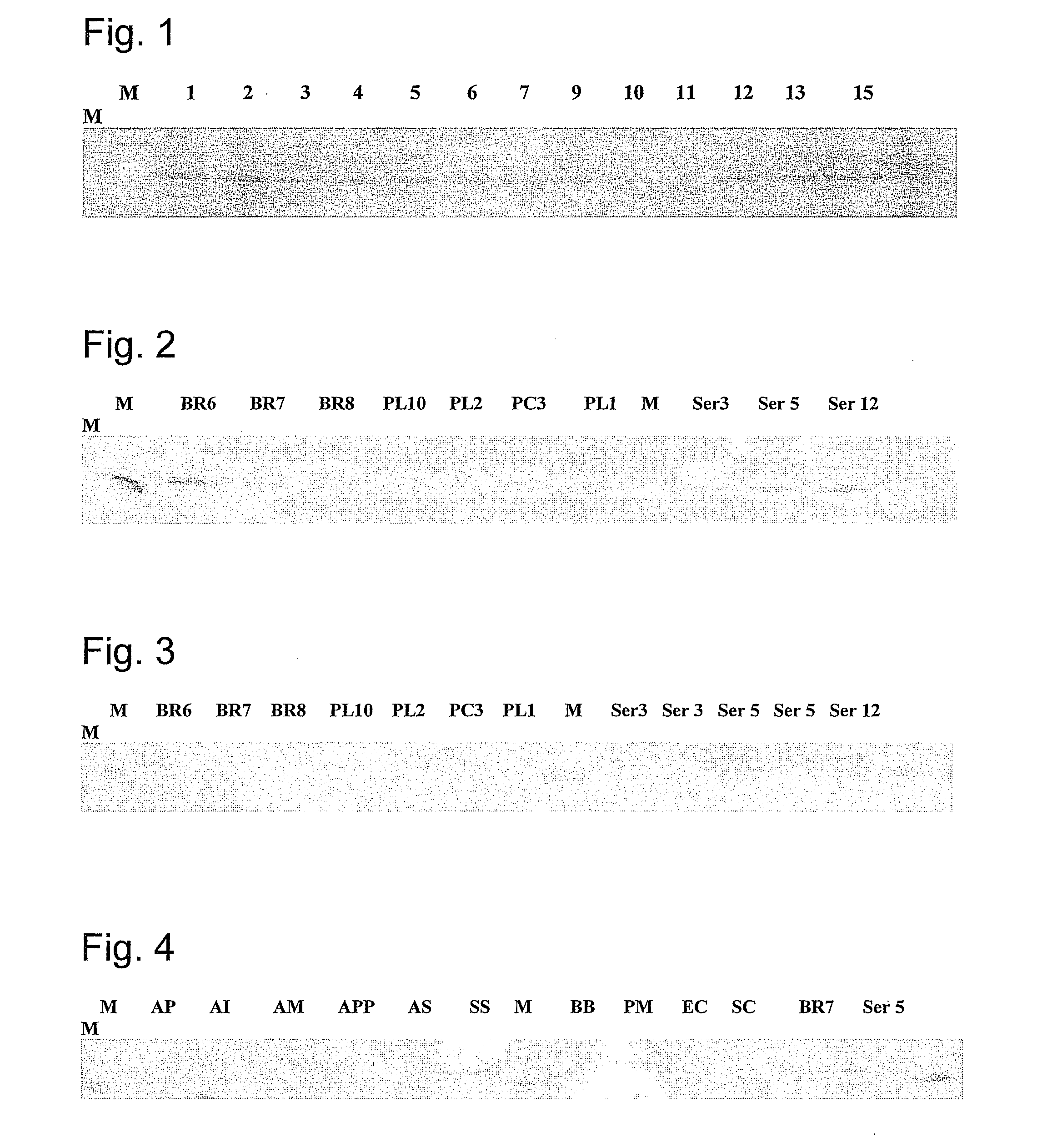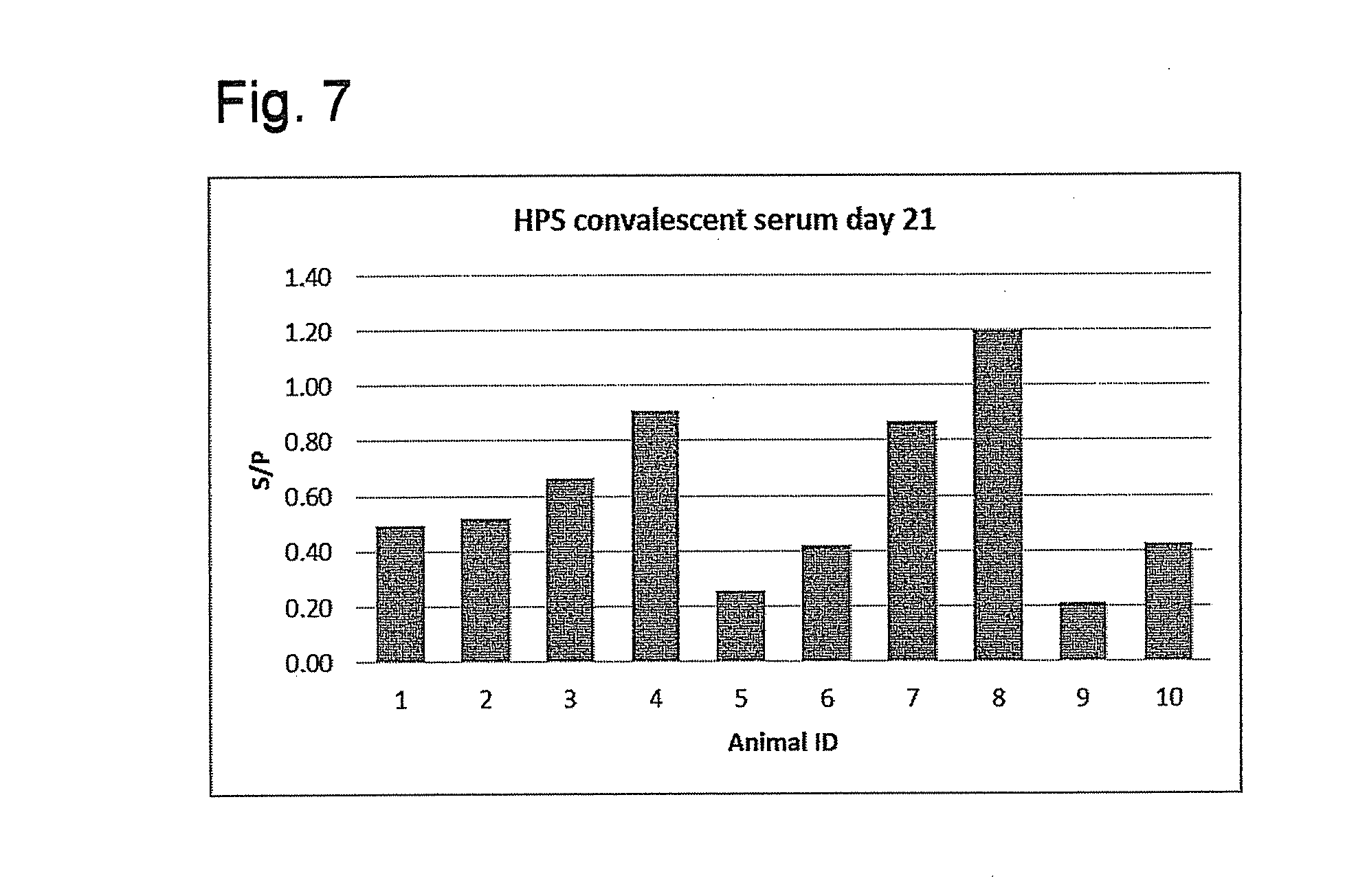Haemophilus parasuis polypeptides and methods of use
a technology of haemophilus parasuis and polypeptides, applied in the field of haemophilus parasuis polypeptides and methods of use, can solve the problems of lack of reliable serological tests and absence of vaccines that suppress disease caused by diseases
- Summary
- Abstract
- Description
- Claims
- Application Information
AI Technical Summary
Benefits of technology
Problems solved by technology
Method used
Image
Examples
example 1
[0109]Twenty pigs involved in an H. parasuis outbreak were selected based on clinical signs (fever >105° F., respiratory distress, lameness, CNS signs) for necropsy and H. parasuis isolation (n=10) or for antibiotic treatment to produce convalescent sera (n=10). Whole cell proteins obtained from H. parasuis isolates recovered from diseased pigs were probed with convalescent serum using Western blot. This serum was used for western blot analysis of the whole cell protein profiles of the outbreak strains and 13 H. parasuis reference strains. Convalescent serum from these pigs strongly reacted to a protein of estimated molecular weight of 52 kDa in all H. parasuis strains tested. This protein was identified in all H parasuis reference strains tested (FIG. 1) and in all field strains obtained from brain, pleura, and pericardium during an outbreak (FIG. 2). Pre-colostrum serum obtained from a 1 day-old piglet was used as a negative control in all Western blots.
[0110]The 52 kDa protein wa...
example 2
[0112]This example details the development of a Haemophilus parasuis OppA ELISA test and validation of the new test using serum samples obtained from different swine herds. Additional serum samples have been tested and validation of the test continues. The samples reported here were carefully planned and demonstrate uses for the ELISA test. Results were evaluated based on sample to positive ratios (S / P). The conclusions were made based on the trends detected. The main conclusions obtained so far include:
[0113]Non-vaccinated, clinically healthy, colonized pigs do not develop antibodies against Haemophilus parasuis OppA;
[0114]Pigs that have survived the peak of Haemophilus parasuis-related nursery mortality develop high titers of anti-OppA IgG; and
[0115]Pigs need to be systemically exposed to Haemophilus parasuis to develop anti-OppA antibodies.
Expression and Purification of OppA
[0116]The OppA polypeptide was expressed and purified by GenScript Corp. (Piscataway, N.J.). Briefly, a cod...
example 3
Experimental Design:
[0123]Conventional healthy pigs are randomly allocated into 2 groups. For instance, twenty-two 3-week old conventional healthy pigs are randomly allocated into 2 rooms with 11 pigs per group (Table 1). Group 1 is vaccinated intramuscularly with the OppA subunit vaccine on days 0 and 14 of the experiment. Group 2 is vaccinated with adjuvant only and will remain as the non-vaccinated control. All pigs are challenged with a serotype 5 H. parasuis strain at the day 28 of the experiment and necropsied at day 35. The sample size used is adequate to detect significant differences between the proportion of affected pigs in the unvaccinated group (expected 80%) and vaccinated group (expected 20%) with 95% confidence and 80% power (Sergeant, ESG, 2009. Epitools epidemiological calculators. AusVet Animal Health Services and Australian Biosecurity Cooperative Research Centre for Emerging Infectious Disease. Available online at the AusVet Animal Health Services internet site)...
PUM
| Property | Measurement | Unit |
|---|---|---|
| ionic strength | aaaaa | aaaaa |
| temperature | aaaaa | aaaaa |
| temperature | aaaaa | aaaaa |
Abstract
Description
Claims
Application Information
 Login to View More
Login to View More - R&D
- Intellectual Property
- Life Sciences
- Materials
- Tech Scout
- Unparalleled Data Quality
- Higher Quality Content
- 60% Fewer Hallucinations
Browse by: Latest US Patents, China's latest patents, Technical Efficacy Thesaurus, Application Domain, Technology Topic, Popular Technical Reports.
© 2025 PatSnap. All rights reserved.Legal|Privacy policy|Modern Slavery Act Transparency Statement|Sitemap|About US| Contact US: help@patsnap.com



